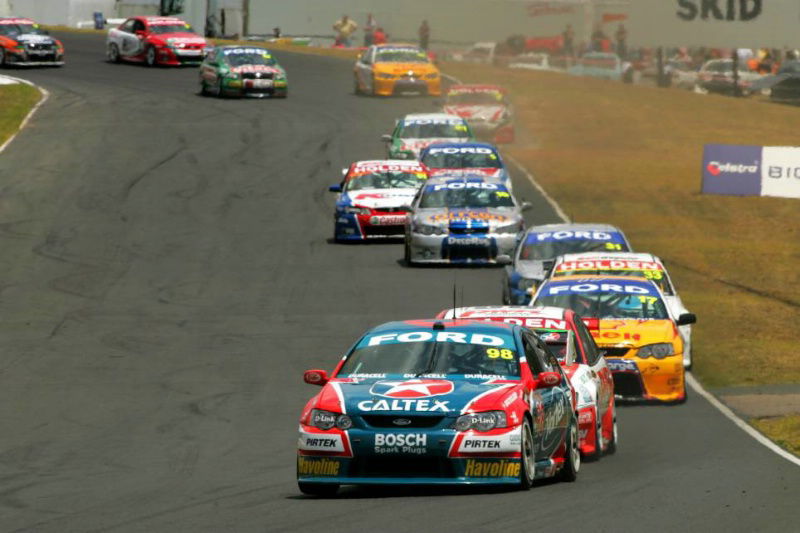Know your racing terms - Pt.3.
With a bit of a break before the opening races of the 2005 V8 Supercar season, back-to-back series champions Stone Brothers Racing have decided to keep the fans' minds ticking over.
SBR has compiled a series of racing terms designed to educate fans and keep them interested during the "off" season.
"I don't think you can ever know enough," Ross Stone said. "We have put these terms together so fans can become more educated on our sport and so they have somthing to keep their interest before we head to the AGP for support races in March.

With a bit of a break before the opening races of the 2005 V8 Supercar season, back-to-back series champions Stone Brothers Racing have decided to keep the fans' minds ticking over.
SBR has compiled a series of racing terms designed to educate fans and keep them interested during the "off" season.
"I don't think you can ever know enough," Ross Stone said. "We have put these terms together so fans can become more educated on our sport and so they have somthing to keep their interest before we head to the AGP for support races in March.
"We hope all V8 Supercar fans had a safe and enjoyable Christmas and New Year and that the terms come in handy as they prepare for what is sure to be a great 2005 season."
Racing terms:
MARBLES:
Bits of rubber scrubbed off of racing slicks while cornering. These small balls collect on the outside of the turn, and if a car goes wide (into the marbles, or "the grey", referring to the lighter appearance of an area covered with marbles), then much adhesion is lost. In addition, this rubber debris will stick to the hot tyres and cause poor traction for the next few corners until they are rubbed off the tyre.
MIRRORS FULL:
Means a driver sees someone trying to pass him on the track.
PADDOCK:
The area where the team transporters are parked, and where the teams work on cars between on-track sessions. In V8 Supercars, this area is usually accessible to the general public.
PIT CREW:
Each team has a number of personnel that work in specific areas of team operations, from accountants to engineers. One elite group of team members travels to each event and serve as the pit crew, servicing the car during pit stops for fuel and tyres and managing the race from the pits, including race strategy and communications.
PIT LANE:
An area adjacent to the track where cars pull in to be refuelled or serviced before and during a race. There is always a maximum speed limit along pit row, usually 40kph.
PIT STOP:
To stop in the pits.
PITS:
The area where cars come in for fuel, tyres, adjustments and repairs during on-track sessions. The name originated from early racetracks, where the mechanics actually stood in a shallow pit where they could duck if an out-of-control car came their way. Today, mechanics are protected by concrete walls, and the pit lane is segregated from the actual racing surface.
PODIUM:
The top three finishers in an event stand on a podium (or stage) to be recognised after the race. The winner is usually in the middle on a higher pedestal, flanked by the second and third-place-finishers.
POLE:
This historic term refers to the driver who starts at the front of the field on the inside of the front row by virtue of the fastest qualifying time. The term originated at horse tracks. The finish and distance markers of a horse track are marked by poles set on the inside edge of the track.
PUSH OR UNDERSTEER:
Typically describes a cornering condition where the front tyres lose adhesion before the rear tyres, resulting in a car that feels like it wants to go straight. Solutions include adjustments to tyre pressure; softening the front anti-roll bar setting or spring rates in order to provide more grip; or by making changes to reduce grip at the rear.
QUALIFYING:
Qualifying determines starting positions, based on each driver's best lap time during the qualifying session or sessions. Each car is timed, and the starting grid is determined by the order of fastest cars.
RAIN TYRES:
Treaded tyres used on a wet track. Also referred to as "Wets."
REBOUND:
In shock absorbers, a rebound adjustment is a change to the dampening of the shock on the expansion stroke. Without rebound dampening, the car would tend to bounce as it passes over bumps on the track. Rebound adjustments can also affect how the weight of the car shifts around during braking, acceleration and cornering.
REV LIMITER:
Modern engines are controlled by electronic "mapping" software that controls things such as fuel consumption and ignition timing. Rev limiting is used for two purposes: to keep the engine from exceeding its maximum rotational speed and exploding into bits of very expensive shrapnel, and to adhere to speed limit rules in the pit lane.
V8 Supercars have a maximum rev limit of 7500rpm. Maximum rev limits are set by the engine manufacturer, while the pit lane rev limiter is controlled by a pushbutton on the steering wheel.
